

Anishinaabe. Emblem of the Anishinaabe people The meaning of Anishinaabeg as described from speakers is 'People from whence lowered'.
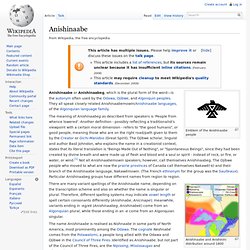
Another definition - possibly reflecting a traditionalist's viewpoint with a certain moral dimension - refers to "the good humans", or good people, meaning those who are on the right road/path given to them by the Creator or Gichi-Manidoo (Great Spirit). The Ojibwe scholar, linguist and author Basil Johnston, who explains the name in a creationist context, states that its literal translation is "Beings Made Out of Nothing", or "Spontaneous Beings", since they had been created by divine breath and were made up of flesh and blood and a soul or spirit - instead of rock, or fire, or water, or wind.[1] Not all Anishinaabemowin speakers, however, call themselves Anishinaabeg. Cherokee mythology. The water spider is said to have first brought fire to the inhabitants of the earth in the basket on her back.[1] This article concerns itself with the Spiritual beliefs of the Cherokee, Native Americans indigenous to the Appalachias, and today are enrolled in the Eastern Band of Cherokee Indians, Cherokee Nation, and United Keetowah Band of Cherokee Indians.
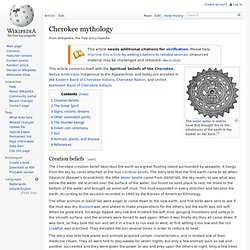
Creation beliefs[edit] The Cherokee creation belief describes the earth as a great floating island surrounded by seawater. It hangs from the sky by cords attached at the four cardinal points. The story tells that the first earth came to be when Dâyuni'sï (Beaver's Grandchild), the little Water beetle came from Gälûñ'lätï, the sky realm, to see what was below the water. The other animals in Gälûñ'lätï were eager to come down to the new earth, and first birds were sent to see if the mud was dry. The story also tells how plants and animals acquired certain characteristics, and is related one of their medicine rituals. Evil[edit] Choctaw mythology. Mississippi Choctaws in traditional clothing, ca. 1908 Choctaw mythology is related to Choctaws, a Native American people originally from the Southeastern United States (Mississippi, Alabama, and Louisiana).
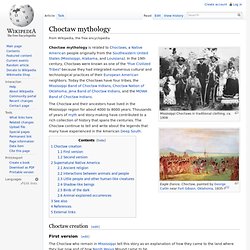
In the 19th century, Choctaws were known as one of the "Five Civilized Tribes" because they had integrated numerous cultural and technological practices of their European American neighbors. Today the Choctaws have four tribes, the Mississippi Band of Choctaw Indians, Choctaw Nation of Oklahoma, Jena Band of Choctaw Indians, and the MOWA Band of Choctaw Indians. The Choctaw and their ancestors have lived in the Mississippi region for about 4000 to 8000 years. Thousands of years of myth and story-making have contributed to a rich collection of history that spans the centuries. Choctaw creation[edit] First version[edit] The Choctaw who remain in Mississippi tell this story as an explanation of how they came to the land where they live now and of how Nanih Waiya Mound came to be.
Creek mythology. History[edit]
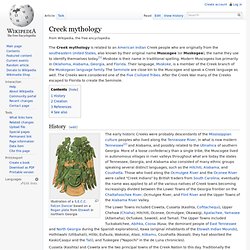
Diné Bahaneʼ. Hopi mythology. The Hopi maintain a complex religious and mythological tradition stretching back over centuries.
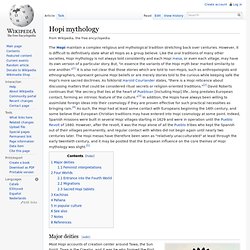
However, it is difficult to definitively state what all Hopis as a group believe. Like the oral traditions of many other societies, Hopi mythology is not always told consistently and each Hopi mesa, or even each village, may have its own version of a particular story. But, "in essence the variants of the Hopi myth bear marked similarity to one another. "[1] It is also not clear that those stories which are told to non-Hopis, such as anthropologists and ethnographers, represent genuine Hopi beliefs or are merely stories told to the curious while keeping safe the Hopi's more sacred doctrines. Major deities[edit] Kuterastan. Kuterastan is the creator in a creation myth of the Kiowa Apache from the southern plains of North America.

His name means One Who Lives Above. The story of his creation tells that in the beginning, before there were earth or sky there was only darkness. Into it came a small and thin disc with yellow and white on its alternate sides, and inside it sat Kuterastan, a small bearded man no larger than a frog. Kuterastan is described as awakening and rubbing his eyes. When he peers above him into the darkness it filled with light and illuminated the darkness below.
Raven in Creation. Bill Reid's sculpture Raven and The First Men, showing part of a Haida creation myth.
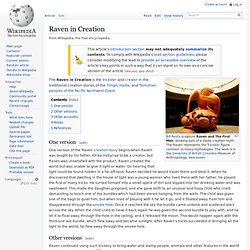
The Raven represents the Trickster figure common to many mythologies. Zuni mythology. Zuni mythology is the oral history, cosmology, and religion of the Zuni people.

The Zuni are a Pueblo people located in New Mexico. Their religion is integrated into their daily lives and respects ancestors, nature, and animals.[1] Because of a history of religious persecution by non-native peoples, they are very private about their religious beliefs. Roman Catholicism has to some extent been integrated into traditional Zuni religion.[1] Cultural institutions that provide religious instruction and cultural stability include their priests, clans, kivas (kachina society), and healing societies.[1] A ceremonial cycle brings the community together. While some ceremonies are open to non-Zuni peoples, others are private; for instance the Shalako ceremony and feast has been closed to outsiders since 1990.[1] Kachinas[edit] A list of Kachinas includes: